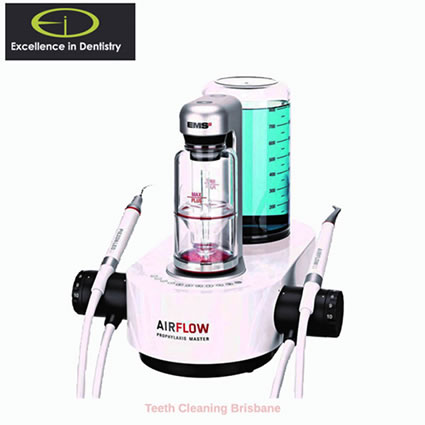 At Excellence in Dentistry we are dedicated to providing our patients with the highest quality dental care possible using the latest equipment such as the Air-flow
At Excellence in Dentistry we are dedicated to providing our patients with the highest quality dental care possible using the latest equipment such as the Air-flow
There are several benefits to using the AIRFLOW Machine, including cleaning of difficult to reach areas like exposed tooth necks, pits, fissures and the space between your teeth as well as wired braces.
Providing a gentler clean which is more comfortable for our patient whilst also more effective than traditional cleaning methods.
What exactly is meant by the term Airflow treatment?
The process of dental hygiene known as airflow therapy involves combining water, compressed air, and tiny powder particles. This results in the removal of persistent tooth stains, plaque, and discoloration.
When brought together, these three components produce a high-powered jet that gently removes stains and biofilm when directed towards the gum line and the areas above and below it. Plaque is a biofilm that accumulates on the mouth’s surfaces and is comprised of disease-causing bacteria.
When can Airflow be used to clean teeth?
Airflow can be used for a range of preventive and restorative dental procedures, including the following:
- Detained plaque removal which prevents gum disorders such as gingivitis and periodontitis.
- Remove stains from teeth.
- Regular maintenance and cleaning around dental implants.
- Clear and polish cracks for sealing.
- Before orthodontic brackets are bonded, the surface must be thoroughly cleaned.
- Before whitening to make sure all the stain and plaque is removed from teeth.
What are the most important advantages of Airflow treatment?
The most important advantages of the treatment are stated below:
- It warms up the water I is using to body temperature so no more sensitivity from routine clean.
- It can remove hard to access or no access plaque buildup more quickly and readily than scaling and polishing.
- Non-painful therapy.
- It can remove tooth discoloration and stain.
- In addition, it penetrates periodontal pockets much more effective than hand instruments to eradicate bacteria that might cause serious gum disease.
- Enhances the efficacy of bleaching operations by eliminating buildup that could impede bleaching.
- Minimally invasive technique.
- No chemicals.
- It is a suitable solution for children.
- After one visit, your smile will be brighter and healthier.
- It is absolutely safe to be used on veneers, crowns, bridges, and implants.
Can Airflow be utilized to treat gum disease?
This is one of the quite significant benefits that may be gained from using airflow. The biofilm, which is a layer of bacteria that attaches to the teeth and gums, is removed during the cleaning process. Plaque on the teeth can become colonized by bacteria, which leads to the formation of a biofilm that is the fundamental factor in gum disease.
Researchers have discovered that removing this biofilm is a necessary step in the treatment of gum disease as well as the upkeep of healthy gums and teeth. As a result of gum disease, there may be deep pockets surrounding the teeth. The cutting-edge Perioflow nozzle has the ability to flex and adapt, allowing it to clean even troublesome spots below the gum line.
How long do the effects of the treatment last?
This is dependent upon your daily routine.
If you take really good care of your teeth at home by using an electric toothbrush for two minutes twice day and flossing or utilizing interdental brushes daily, the effects will stay longer.
Smoking, red wine, tea, coffee, curry, and mouthwashes containing chlorhexidine (such as Corsodyl) will re-stain teeth. If you engage in more of these, the effects of AirFlow® will not be as long-lasting.
People who clean well and have healthy enamel and $are exposed to few stains may only require a cleaning once or twice a year. The bigger the number of risk factors you have, the more likely it is that you will need to return sooner, potentially as frequently as every three months.
What are the differences between EMS Airflow and traditional teeth cleaning methods?
- Using the EMS Airflow tool takes less time – you’ll get your teeth cleaned in half the time or less, compared to traditional teeth cleaning methods
- Traditional teeth cleaning methods may use dental scrapers to remove plaque deposits – EMS Airflow uses air, which reduces any impacts on the surface of your dental enamel
- The EMS Airflow is very quiet, providing comfort to noise-averse patients. Many patients don’t like the noise which occurs when dental staff use manual scrapers to clean teeth.
- Patients get a deeper clean with EMS Airflow particularly if they have deep pockets.
Who Is Airflow Suitable For?
We understand that many patients be worried about experiencing any pain. This treatment is a very gentle and non-abrasive procedure making it suitable for suitable for:
- Great for anxious patients.
- Perfect for those who have sensitive teeth.
- Suitable for those with implants
- Suitable if you are wearing wearing braces
- Suitable for Children
What is the cost of air polishing treatment?
In general, dental offices offer two alternatives for air polishing. Your options will depend on the state of your teeth and gums prior to beginning treatment.
A normal scaling technique (using ultrasonic or manual scalers) is the first alternative, which may be necessary if you have a great deal of old calculus. Then, air polishing is utilized for stain removal and finer cleaning. This will result in you having to pay for both a routine hygiene appointment and an airflow appointment. Expect to pay between $90-$130 on average for this type of treatment.
Air polishing could suffice if you have very modest stains and minimal calculus.